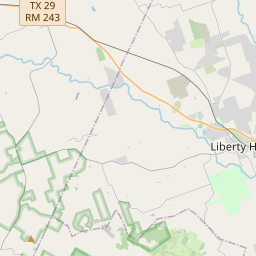Ku Klux Klan Trials
Historical marker location:






In the 1920s, the Ku Klux Klan (KKK) was a nationwide organization that openly preached white supremacy and hatred for Blacks, Jews, Catholics, and Immigrants. In Texas, Klan membership peaked in 1923 with upwards of 150,000 members. Klansmen influenced and held positions in local and state government and in law enforcement. Their power allowed members to engage in acts of vigilante violence without fear of prosecution. Although their primary targets were people of color, the Klan also threatened Anglos who disagreed with the KKK’s core values.
On Easter Sunday 1923, ten Klansmen flogged and tarred Robert Burleson, a white traveling salesman, after Burleson ignored their warning to leave Georgetown. District Attorney Dan Moody, a Taylor native, led prosecution against the Klansmen in a series of trials between September 1923 and February 1924. Moody tried his strongest case first against Klansman Murray Jackson. After seven days of arguments, the jurors deliberated for twenty minutes before returning a guilty verdict and offering the maximum punishment for the crime. Moody’s initial conviction led to four additional convictions and four prison sentences for the other Georgetown Klansmen on trial at the Williamson County Courthouse.
These trials were considered the first prosecutorial success in the United States against members of the 1920s Klan and quickly weakened the Klan’s political influence in Texas. Further, the publicity garnered by Moody following the trial led to his successful runs for State Attorney General in 1924 and Texas Governor in 1926 and 1928. He was the youngest person ever elected to both statewide offices.
(2009)
As one of the most visible programs of the Texas Historical Commission (THC), historical markers commemorate diverse topics in Texas history, including: the history and architecture of houses, commercial and public buildings, religious congregations, and military sites; events that changed the course of local and state history; and individuals who have made lasting contributions to the state, community organizations, and businesses.
The discovery of oil in 1901 near Beaumont, Texas, sparked an oil boom that transformed the state's economy and led to the rise of the modern petroleum industry.
The region was first settled by European pioneers in the mid-19th century. The establishment of Fort Tumlinson in 1839 provided protection to settlers, and the population grew steadily with the arrival of more immigrants in search of new opportunities. In 1848, the county was officially organized and named after Robert McAlpin Williamson, a judge and soldier in the Republic of Texas.
During the Civil War, Williamson County faced significant challenges. Many residents joined the Confederate Army, and the county became a hotbed of conflict due to its location on the frontier between Union and Confederate territories. After the war, the area was able to rebuild and experienced a period of economic growth, driven by agriculture, cattle ranching, and the emergence of small towns and rural communities.
In the 20th century, Williamson County continued to develop and adapt to changing times. The discovery of oil in the early 1900s brought economic prosperity to the region, and the county experienced a boom in population and infrastructure. Today, Williamson County is a thriving part of the greater Austin metropolitan area, known for its strong economy, vibrant communities, and commitment to preserving its historical roots.
Williamson County Timeline
This timeline provides a condensed summary of the historical journey of Williamson County, Texas.
- 1804 - The area that is now Williamson County is settled by Native American tribes, including the Tonkawa, Lipan Apache, and Comanche.
- 1836 - Texas gains independence from Mexico.
- 1838 - The Texas legislature establishes Williamson County, named after Robert McAlpin Williamson, a leader in the fight for Texas independence.
- 1848 - The Mexican-American War ends and the Treaty of Guadalupe Hidalgo is signed, officially establishing the Rio Grande as the boundary between Texas and Mexico.
- 1850 - The population of the county reaches 1,027.
- 1876 - The Texas State Capitol building is completed in Austin, which becomes the seat of government for Williamson County.
- 1881 - The International-Great Northern Railroad reaches Georgetown, bringing economic growth and development to the county.
- 1907 - The county courthouse, located in Georgetown, is completed.
- 1930s - The Great Depression hits Williamson County, causing a decline in the local economy.
- 1950s - The county experiences a period of growth and prosperity, with the population increasing significantly.
- 1990s - Development and suburbanization accelerate in Williamson County, with the county becoming one of the fastest-growing areas in the United States.